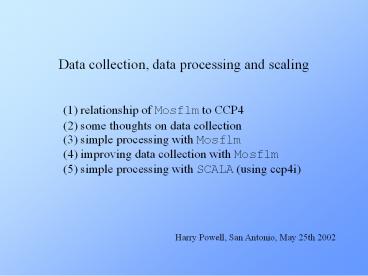Data collection, data processing and scaling - PowerPoint PPT Presentation
Title:
Data collection, data processing and scaling
Description:
Data collection, data processing and scaling (1) relationship of Mosflm to CCP4 ... when viewed with the CCP4 graph viewer LOGGRAPH, as it contains graphs of ... – PowerPoint PPT presentation
Number of Views:31
Avg rating:3.0/5.0
Title: Data collection, data processing and scaling
1
Data collection, data processing and scaling
(1) relationship of Mosflm to CCP4 (2) some
thoughts on data collection (3) simple processing
with Mosflm (4) improving data collection with
Mosflm (5) simple processing with SCALA (using
ccp4i)
Harry Powell, San Antonio, May 25th 2002
2
(No Transcript)
3
Number of Datasets 1 Dataset ID,
project/crystal name, dataset name, cell
dimensions, wavelength 1 lys_fine /
02_05_02135350 78.1485
78.1485 37.0149 90.0000 90.0000 90.0000
1.54180 Number of Columns 16
Number of Reflections 13368 Missing
value set to NaN in input mtz file Number
of Batches 50 HISTORY for current MTZ
file From MOSFLM run on 2/ 5/02
ltsnipgt Resolution Range 0.00089
0.17159 ( 33.520 - 2.414 A )
There is no sort order recorded in the MTZ
header Space group P43212 (number 96)
4
(No Transcript)
5
Optimization of Data Collection
- Pre-process at least one image (preferably two at
90º to each other) to obtain - Cell parameters, crystal orientation and putative
Laue group - Estimate of mosaicity
- Effective resolution limit
- Crystal to detector distance
- Exposure time
- Strategy for data collection
Remember! This is the last experimental stage -
if you collect bad data now you are stuck with
it. No data processing program can rescue the
irredeemable!
6
What is needed prior to running Mosflm?
- X-ray images
- Experimental details (e.g. detector type, direct
beam position, wavelength, etc) - The program itself and a computer to run it on!
7
localhost/test/muldlx1 harry ls
mar2000 muldlx1_301.mar2000
muldlx1_307.mar2000 muldlx1_313.mar2000
muldlx1_319.mar2000 muldlx1_302.mar2000
muldlx1_308.mar2000 muldlx1_314.mar2000
muldlx1_320.mar2000 muldlx1_303.mar2000
muldlx1_309.mar2000 muldlx1_315.mar2000
muldlx1_321.mar2000 muldlx1_304.mar2000
muldlx1_310.mar2000 muldlx1_316.mar2000
muldlx1_322.mar2000 muldlx1_305.mar2000
muldlx1_311.mar2000 muldlx1_317.mar2000 muldlx1
_306.mar2000 muldlx1_312.mar2000
muldlx1_318.mar2000 localhost/test/muldlx1
harry ipmosflm Version 6.2.1 for
Image plate and CCD data 23 April 2002
A.G.W. Leslie, MRC Laboratory Of
Molecular Biology, HILLS ROAD, CAMBRIDGE CB2 2QH,
UK E-mail andrew_at_mrc-lmb.cam.ac.uk New
auto-indexing using DPS due to Ingo Steller
Robert Bolotovsky and Michael Rossmann (1998) J.
Appl. Cryst. 30, 1036-1040 Original
auto-indexing using REFIX due to Wolfgang Kabsch
(Kabsch,W. (1993), J.Appl.Cryst. 24,795-800.)
X-windows interface using xdl_view due to John
Campbell (Daresbury Laboratory, UK.)
(Campbell,J.W. (1995) J. Appl. Cryst. 28,
236-242. MOSFLM gt image muldlx1_301.mar2000
MOSFLM gt go (Q)QOPEN file opened on unit 1
Status READONLY ltBgtltFONT COLOR"FF0000"gtlt!--
SUMMARY_BEGIN--gt Logical Name
muldlx1_301.mar2000 Filename
muldlx1_301.mar2000 lt!--SUMMARY_END--gtlt/FONTgtlt/Bgt
Crystal to detector distance of 250.00mm
taken from image header Wavelength of 1.54180A
taken from image header
8
Crystal to detector distance of 250.00mm taken
from image header Wavelength of 1.54180A taken
from image header Pixel size of 0.1500mm taken
from image header. Start and end phi values for
image 1 from image header are 279.00 and
280.00 degrees. image FILENAME
muldlx1_301.mar2000 (Q)QOPEN file opened on
unit 1 Status READONLY ltBgtltFONT
COLOR"FF0000"gtlt!--SUMMARY_BEGIN--gt Logical
Name muldlx1_301.mar2000 Filename
muldlx1_301.mar2000 lt!--SUMMARY_END--gtlt/FONTgtlt/Bgt
The red circle denotes the region behind the
backstop shadow (Use BACKSTOP keyword to set
this.)
9
(No Transcript)
10
(No Transcript)
11
(No Transcript)
12
(No Transcript)
13
(No Transcript)
14
(No Transcript)
15
(No Transcript)
16
Running the STRATEGY option
- In the GUI, click on the STRATEGY button
- On the command-line, type STRATEGY.
- In either case, determining a suitable strategy
for data collection once you have a cell,
orientation and crystal symmetry is
straightforward. - Then run TESTGEN to check for overlaps
17
(No Transcript)
18
Checking the output (1)
- There are two useful log files
- SUMMARY this is of most use when viewed with the
CCP4 graph viewer LOGGRAPH, as it contains graphs
of parameters which have varied through the data
processing. - mosflm.lp this can be very large, and contains a
complete record of the experiment.
19
(No Transcript)
20
(No Transcript)
21
Checking the output (2)
- If everything has gone right so far
- check the MTZ file is it as youd expect?
22
Command-line processing
Most commands in the GUI are available from the
command-line e.g. for the test images, the
following could be done detector mar
! not necessary here! template
muldlx1_.pck beam 149.79 150.87 autoindex dps
image 301 mosaic estimate go postref segment 1
process 301 303 go postref nosegment fix
all process 301 322 go exit
23
(No Transcript)
24
(No Transcript)
25
Checking the output of SCALA
- Check these files/plots
- ROGUES
- Normal probability plot(s)
- Surface plot
- SCALA log file
- loggraph output
26
(No Transcript)
27
(No Transcript)






























